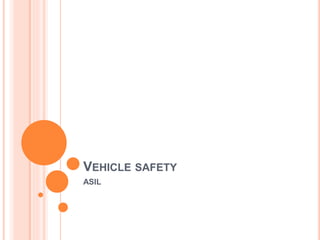
Vehicle safety integrity levels
- 2. VEHICLE SAFETY(ASIL) Automotive Safety Integrity Level(ASIL) is of classifying hazards, risk, quality, or reliability scheme defined by the ISO 26262 - Functional Safety for Road Vehicles standard. The ASIL is established by performing a risk analysis of a potential hazard by looking at the Severity, Exposure and Controllability of the vehicle operating scenario. There are four ASILs identified by the standard: ASIL A, ASIL B, ASIL C, ASIL D. ASIL D dictates the highest integrity requirements on the product and ASIL A the lowest. In the context of ISO 26262, a hazard is assessed in terms of severity of possible injuries within the context how much of the time a vehicle is exposed to the possibility of the hazard happening as well as the relative likelihood that a typical driver can act to prevent the injury. In short, ASIL refers both to risk and to risk-dependent requirements Whereas risk may be generally expressed as: Risk=(expected loss in case of the accident) x (probability of the accident occurring) and ASIL may be expressed as: ASIL= Severity X Exposure X Controllability
- 3. The severity (S) of injuries can be classified as: S0 No Injuries S1 Light to moderate injuries S2 Severe to life-threatening (survival probable) injuries S3 Life-threatening (survival uncertain) to fatal injuries Exposure (E) (the relative expected frequency of the operational conditions in which the injury can possibly happen) and classified as: E0 Incredibly unlikely E1 Very low probability (injury could happen only in rare operating conditions) E2 Low probability E3 Medium probability E4 High probability (injury could happen under most operating conditions) Controllability Classifications (C): C0 Controllable in general C1 Simply controllable C2 Normally controllable (most drivers could act to prevent injury) C3 Difficult to control or uncontrollable So, ASIL D is the highest level of hazard and can be computed as: ASIL D= S3*E4*C3 For each single reduction in any one classification from its maximum value (excluding reduction of C1 to C0), there is a single level reduction in the ASIL from D. [For example, a hypothetical uncontrollable (C3) fatal injury (S3) hazard could be classified as ASIL A if the hazard has a very low probability (E1).] The ASIL level A is the lowest level,